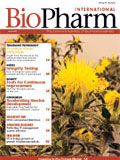Publication
Article
BioPharm International
The Case for Disposable Manufacturing Equipment to Accelerate Vaccine Development
Author(s):
Disposables can be used for media preparation, clarification, filling in downstream processes . . .
If there's one thing that avian flu is doing to benefit vaccine development, it is instigating the transition from egg-based, to cell-based, technologies. Even without avian flu concerns, traditional flu vaccine production is a long and difficult process, requiring that millions of eggs be ordered one or two years ahead of time. The 50-year old process also offers little opportunity for ramp-up in the case of a pandemic or a major compliance failure. To compensate for some of these shortcomings, many vaccine manufacturers are turning to disposable technologies to improve the safety and efficiency of existing processes.

Hélène Pora
Disposables eliminate the need for cleaning and cleaning validation. Discarding a device, without proving that it has been sufficiently cleaned, is one step that both regulatory bodies and manufacturers are happy to eliminate. This is especially true for vaccines, because vaccinating large, healthy populations carries much greater risks than treating relatively small groups of people with conventional drugs. For manufacturers attempting to minimize the risks of vaccine batch contamination, disposables provide an important avenue for enhanced safety.

DISPOSABLES ARE ECONOMICAL
The use of disposable technologies is particularly economical for campaign-based vaccine manufacture. Disposables ensure fast set-up, they reduce the need for capital investment in stainless steel equipment, and require little work after use.
Single-use systems that the supplier pre-sterilizes and bundles together can further simplify set-up. With fewer opportunities for operator error, disposable technologies also improve safety and production economics. Some disposables, such as bags, also save space, because they lie flat and can be stacked before use. Unlike permanent storage tanks, disposable bags are ordered on an as-needed basis to avoid excess unused equipment.

Figure 1. Disposable technologies can be used in many stages of vaccine production. Solid circles indicate ideal steps where disposable technologies can be applied. Dotted circles indicate where technology is applicable, with hardware support.
CELL-BASED VACCINE MANUFACTURING
Although new vaccines are still being developed using traditional egg-based technologies, the race to produce vaccines from cell-based technologies is heating up with a non-egg production method projected to be on the market by 2008, according to Gbola Amusa, a research analyst from Bernstein Research.1 While there are currently no cell-based vaccines beyond early clinical trial phases in the United States, Solvay Pharmaceuticals has a cell-based flu vaccine approved for use in the Netherlands.
The use of disposables in egg-based vaccine manufacture can be seen as preparation for the transition to mammalian cell-based development, where single-use systems are becoming more common. While single-use technologies can play a prominent role in egg-based vaccine manufacture in the areas of filtration, storage, and at connection points, their use multiplies in cell-based applications. More specifically, disposable technologies can be used for media preparation, clarification, buffer preparation, capture, and polishing chromatography steps, filling in downstream processes, and for venting and cell harvesting in upstream processes.
Disposable bioreactors are an example of the growing role of single-use technologies in upstream processing. Despite the availability of increasingly large disposable bioreactors, the material strength of the cell bag and the ability to supply adequate mixing remain a challenge. Although large volume (over 1,000 L) disposable bioreactors are probably a few years away, current offerings are commonly used in smaller cell culture applications, as well as for growing seed innoculums while the large stainless tanks are being prepared.
ESTABLISHING CONNECTIONS
If there is one operation that is ubiquitous throughout biopharmaceutical production, it is the process of making connections. Common connection points occur between two fluid pathways or between stainless steel equipment and media bags. Hundreds of these connections are made every day during full-scale vaccine production, accounting for many hours of labor. Disposable aseptic connection devices that are used to connect two fluid pathways, as well as single-use, steam-in-place connectors that allow fluids to pass from the media bag into the bioreactor and vice versa, can significantly reduce the time and number of steps required to establish these connections. They also reduce bottlenecks in manufacturing environments.
These devices differ from traditional connection methods, such as "quick connectors" and tubing welders, in that they enable a connection to be made in a non-controlled environment in a matter of seconds. By contrast, quick connectors require assembly under a laminar flow hood, and tubing welders mandate the use of a welding device. It generally takes 15-to-20 minutes to set up a laminar flow hood, plus the time required to make the actual connections. Similarly, connections using tubing welders take approximately 5-to-10 minutes to perform, and like laminar flow hoods, they require validation and record-keeping.
These newer aseptic connection methods allow connections to be made in seconds, because they do not require the use of a laminar flow environment or tubing welder. Single-use aseptic connectors can be supplied pre-sterilized by gamma irradiation or can be autoclaved up to 130 °C. Disposable steam-in-place connections can be gamma irradiated, steamed up to 130 °C, or autoclaved up to 128 °C.
The use of disposable sterilizing grade filters also plays an important role in increasing the speed and safety of egg-based flu vaccine manufacture. Because filter capsules are available in a variety of configurations, they can be used to support processes as they are scaled up. Ideally, these differently sized capsules contain identical filter media and hardware materials. This helps ensure that scale-up and scale-down studies yield relevant information and minimum requalification for various batch sizes. These filters form the core of fully-integrated single-use systems that are available pre-sterilized by the supplier. Aside from eliminating cleaning and cleaning validation, the reduced set-up time associated with these systems is critical to the time-sensitive demands of vaccine manufacture.
A STEP TOWARDS DISPOSABLES
The role that disposable technologies play in helping bridge the gap between egg-based methods and conventional cell-based processes will only increase as flu pandemic concerns mount. The fact that disposable technologies are being used for many vaccines that are currently in development reinforces the growth potential of this processing approval. Government and non-governmental agencies are increasing efforts to advance the cause of better vaccine production methods, and many drug companies are following suit by applying greater resources to developing new production methods and optimizing older ones. Despite the challenges facing manufacturers, the life-saving potential and vast market that exists for vaccines will continue to drive innovation in this critical area.

Quick Recap
Hélène Pora is marketing director, Pall Lifes Sciences, Pall France, 3 rue des Gaudines - B.P. 5253, 78175 Saint Germain-en-Laye Cedex-France, tel 33.1.3061.32.20, .fax 33.1.30.51.57.08, hpora@pall.com
REFERENCE:
1. Smith A. A bird flu vaccine without eggs? French drug maker Sanofi and others working on a flu vaccine sans oeufs, CNN Money, Oct. 21, 2005; http://money.cnn.com/2005/10/21/news/fortune500/egg.

Newsletter
Stay at the forefront of biopharmaceutical innovation—subscribe to BioPharm International for expert insights on drug development, manufacturing, compliance, and more.





